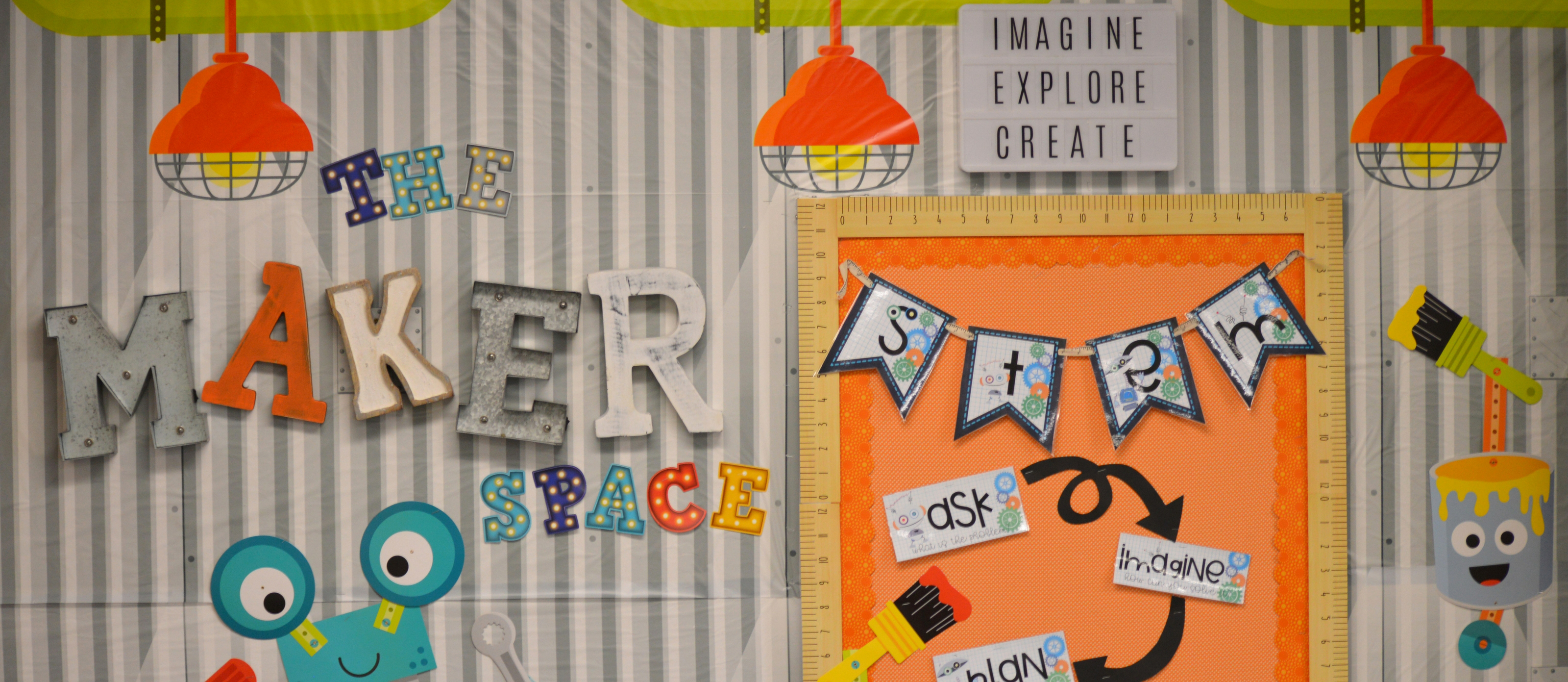What is a makerspace? Well I am glad you asked... mak·er·spaceˈmākərˌspās/ noun
- A place in which people with shared interests, especially in computing or technology, can gather to work on projects while sharing ideas, equipment, and knowledge.
So in a nutshell makerspaces provide hands-on, creative ways to encourage students to design, experiment, build and invent as they deeply engage in science, engineering and tinkering. Sounds great right, but what does that actually look like? Up until a couple of months ago I had no idea what a makerspace was. I kept hearing the buzzwords, "makerspace", "tinker time", and "genius hour", but had no idea what they actually meant. So I searched them out, I asked a lot of questions and watched one in action at a school in my county. Once I saw one of these spaces in use I was hooked. I immediately wanted to incorporate a makerspace into my classroom. After reading, searching and talking with other teachers, my impression was that each one looked very different. There were three things, however, that remained the same. It needed to be meaningful, student centered and functional. I decided that I would jump in and create a space that worked for me while keeping those three things in mind.
I first chose an area in my room that was underutilized and needed an upgrade. Everyone has that one corner with a tiny bulletin board and blah walls that they would love to see transformed. I made sure there was a bookshelf nearby for some storage and floor space in front for my students to explore. I started transforming those blah walls with a gears workroom backdrop. It is similar to a plastic tablecloth and comes in two sections. It was super easy to hang. As soon as I slid it onto the wall the static cling helped to hold it in place. I just stapled it into my wall to secure it. I was so pleased with how it looked! It completely transformed the once plain corner of my room. I got to work using some fabric, robot cutouts and STEM accessories to decorate the bulletin board. It is small so I wanted to keep it simple and clear. I highlighted the essence of STEM activities. Ask--Imagine--Plan--Create--Improve. This process will help take my students from questioning to improving upon their unique ideas. To keep with the industrial look I went on the hunt for some creative lettering. I searched local hobby stores and discount bins and found the perfect combo. Once the space was decorated it was time to get organized.
I started with storage. I needed an easily accessible way to keep items contained; something that can easily be accessed, and items can be exchanged in and out, without a lot of effort. I settled on these fun metal paint cans from my local hardware store. They were cheap and easy to decorate, the kids can bang them around and it will just add to their charm. I just love the industrial look they have. I dressed them up with some fun robot border trim. I just wrapped it around and used hot glue to secure the back. I created some fun lettering using a vinyl cutting machine and applied it to the cans. For three of them I labeled what was inside. For the other three I left them non-specific just labeling them imagine, explore and create. This will enable me to be able to keep the items in my makerspace fluid and fun, I can exchange them out for various themes and activities.
I wanted to keep my makerspace kid-friendly and spacious so I didn't use tables or desks to define the space. I allowed for a section of our tile floor to serve as the base for their creations. This will provide easy clean up if materials get messy and will also not constrain their creativity. I found some fun wooden totes that look like colorful toolboxes. These were the perfect size for little hands. I labeled them and filled them with fun creative materials that will easily spark creativity and imagination.
Now for the fun stuff! What's inside those cans and totes? While I'd like for the bulk of my makerspace to include recycled items, paper, art supplies, and electrical odds and ends I decided that we needed a starting point. While the idea of a makerspace gets introduced to my students I needed items that were easy for students to explore and create with. I filled those shelves with a few of my favorites.
Spinning gear magnets, Marble run building set, Dive into shapes sea and build geometry set, Learning ResourcesTumble Trax Magnetic Marble Run, Guidecraft powerclix building set are just a few of the products that I fell in love with from Learn365. They are all very durable, colorful and come with great learning guides to help get your ideas started. The Guidecraft powerclix building set is very versatile and was quickly a class favorite. The pieces are interchangeable and different shapes can be used to create your designs. One of the first items created was a drawbridge design. It was neat to watch as my students improved their design to meet their needs.
The Dive into shapes Sea and build geometry set was fun to use as we explored geometric shapes. The colorful cards help identify what shapes are needed to create the geometrical figures. My students had a fun time working with partners. One student would give the other the essential pieces from the card and then would say, "What shape can you create?" It was neat to see what shapes they would come up with that were not on the card.
For the items that required magnets I had to get creative and think outside the box. I wanted an area that was big enough for two or three students to explore at the same time if needed. I came across large drip pans at a local auto parts store for around $10. They were perfect, magnetic and lightweight. I used heavy-duty velcro to adhere them to the wall so there wouldn't be any damage and it would hold securely.
Now my students can use the Spinning gear magnets and Marble Run building set with ease. This area also makes a good place to post plans or ideas as they are creating. An added bonus is that dry erase markers work nicely on it as well. These educational toys might seem like they are just for fun but they are the launching pad for understanding how and why things work. While students create a marble run on the magnetic board they explore gravity, friction and inertia just to name a few. They then translate that into creating a 3D model of a marble run using the Marble Run building set.
Once they understand the properties at hand and the science behind it they can move on to creating their own marble run. You could use recycled materials, poster board and tape to get started. You could extend and apply it to physical science by having them explain a type of energy being used in their design. Unleashing your students from the uniform expectations is where you will see their ideas and creativity blossom. It is also where they will make their deepest connections and learn from their experience.
Now that you have had a sneak peek into visually what my makerspace looks like you will have a better understanding as to how and when my students will use it. We all have complicated schedules and district obligations that we have to fulfill so I know it isn't realistic to just think your students will come to school and tinker all day, though we wish they could. Realistically I plan on incorporating it into my science/social studies time. Once a week they will each have an opportunity to participate in a "genius hour." Simply put, it will be an hour where the investigations and projects are student led and implemented. They will start by asking a question related to our unit of study. The next step will be doing research using the library or internet or other resources available. Then they will move on to creating a plan related to their question from their plan they will create. This might be a model, drawing etc. Once they have showcased their product they will document how it could be improved. Now this process might take them 3 or 4 weeks to complete so there is no deadline or timetable exploration. As the teacher you are there to help model the framework and move students through the steps. The goal of my genius hour is to not only foster independent thinking but to spark critical thinking. How will the student engage in the activity when they aren't constricted and are free to think on their own? I am interested to see how this type of inquiry helps my students in their own learning process and journey.
So I encourage you to get creative and set the stage for your students. Help them to think beyond the workbook pages and spark their own critical thinking. Reach out to other teachers and see what has worked for them, there is no one way to implement a makerspace so enjoy the process and start envisioning yours today. I can't wait to see what you dream up!

